Input interpretation

bis trimethylsilyl amide
Basic properties
(C)[N-][Si](C)(C)C InChI identifier | InChI=1/C6H18NSi2/c1-8(2, 3)7-9(4, 5)6/h1-6H3/q-1 InChI key | XGIUDIMNNMKGDE-UHFFFAOYSA-N](../image_source/95605db12c8fe8146c381b1f033990c4.png)
molar mass | 160.4 g/mol formula | (C_6H_18NSi_2)^- empirical formula | C_6Si_2N_H_18 SMILES identifier | C[Si](C)(C)[N-][Si](C)(C)C InChI identifier | InChI=1/C6H18NSi2/c1-8(2, 3)7-9(4, 5)6/h1-6H3/q-1 InChI key | XGIUDIMNNMKGDE-UHFFFAOYSA-N
Lewis structure
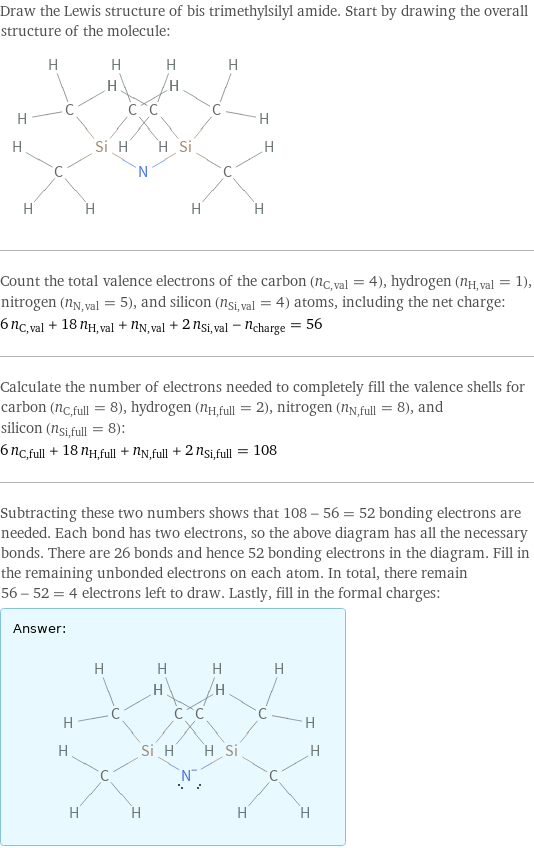
Draw the Lewis structure of bis trimethylsilyl amide. Start by drawing the overall structure of the molecule: Count the total valence electrons of the carbon (n_C, val = 4), hydrogen (n_H, val = 1), nitrogen (n_N, val = 5), and silicon (n_Si, val = 4) atoms, including the net charge: 6 n_C, val + 18 n_H, val + n_N, val + 2 n_Si, val - n_charge = 56 Calculate the number of electrons needed to completely fill the valence shells for carbon (n_C, full = 8), hydrogen (n_H, full = 2), nitrogen (n_N, full = 8), and silicon (n_Si, full = 8): 6 n_C, full + 18 n_H, full + n_N, full + 2 n_Si, full = 108 Subtracting these two numbers shows that 108 - 56 = 52 bonding electrons are needed. Each bond has two electrons, so the above diagram has all the necessary bonds. There are 26 bonds and hence 52 bonding electrons in the diagram. Fill in the remaining unbonded electrons on each atom. In total, there remain 56 - 52 = 4 electrons left to draw. Lastly, fill in the formal charges: Answer: | |
Quantitative molecular descriptors
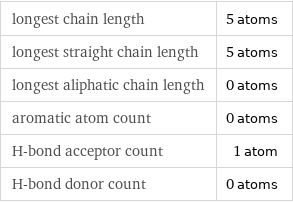
longest chain length | 5 atoms longest straight chain length | 5 atoms longest aliphatic chain length | 0 atoms aromatic atom count | 0 atoms H-bond acceptor count | 1 atom H-bond donor count | 0 atoms
Elemental composition

Find the elemental composition for bis trimethylsilyl amide in terms of the atom and mass percents: atom percent = N_i/N_atoms × 100% mass percent = (N_im_i)/m × 100% Plan: • Write the chemical formula and gather atomic masses from the periodic table. • Determine values for N_i, m_i, N_atoms and m using these items. • Finally, compute the percents and check the results. Write the chemical formula: (C_6H_18NSi_2)^- Use the chemical formula, (C_6H_18NSi_2)^-, to count the number of atoms, N_i, for each element and find the total number of atoms, N_atoms: | number of atoms C (carbon) | 6 Si (silicon) | 2 N (nitrogen) | 1 H (hydrogen) | 18 N_atoms = 6 + 2 + 1 + 18 = 27 Divide each N_i by N_atoms to calculate atom fractions. Then use the property that atom fractions must sum to one to check the work: | number of atoms | atom fraction C (carbon) | 6 | 6/27 Si (silicon) | 2 | 2/27 N (nitrogen) | 1 | 1/27 H (hydrogen) | 18 | 18/27 Check: 6/27 + 2/27 + 1/27 + 18/27 = 1 Compute atom percents using the atom fractions: | number of atoms | atom percent C (carbon) | 6 | 6/27 × 100% = 22.2% Si (silicon) | 2 | 2/27 × 100% = 7.41% N (nitrogen) | 1 | 1/27 × 100% = 3.70% H (hydrogen) | 18 | 18/27 × 100% = 66.7% Look up the atomic mass, m_i, in unified atomic mass units, u, for each element in the periodic table: | number of atoms | atom percent | atomic mass/u C (carbon) | 6 | 22.2% | 12.011 Si (silicon) | 2 | 7.41% | 28.085 N (nitrogen) | 1 | 3.70% | 14.007 H (hydrogen) | 18 | 66.7% | 1.008 Multiply N_i by m_i to compute the mass for each element. Then sum those values to compute the molecular mass, m: | number of atoms | atom percent | atomic mass/u | mass/u C (carbon) | 6 | 22.2% | 12.011 | 6 × 12.011 = 72.066 Si (silicon) | 2 | 7.41% | 28.085 | 2 × 28.085 = 56.170 N (nitrogen) | 1 | 3.70% | 14.007 | 1 × 14.007 = 14.007 H (hydrogen) | 18 | 66.7% | 1.008 | 18 × 1.008 = 18.144 m = 72.066 u + 56.170 u + 14.007 u + 18.144 u = 160.387 u Divide the mass for each element by m to calculate mass fractions. Then use the property that mass fractions must sum to one to check the work: | number of atoms | atom percent | mass fraction C (carbon) | 6 | 22.2% | 72.066/160.387 Si (silicon) | 2 | 7.41% | 56.170/160.387 N (nitrogen) | 1 | 3.70% | 14.007/160.387 H (hydrogen) | 18 | 66.7% | 18.144/160.387 Check: 72.066/160.387 + 56.170/160.387 + 14.007/160.387 + 18.144/160.387 = 1 Compute mass percents using the mass fractions: Answer: | | | number of atoms | atom percent | mass percent C (carbon) | 6 | 22.2% | 72.066/160.387 × 100% = 44.93% Si (silicon) | 2 | 7.41% | 56.170/160.387 × 100% = 35.02% N (nitrogen) | 1 | 3.70% | 14.007/160.387 × 100% = 8.733% H (hydrogen) | 18 | 66.7% | 18.144/160.387 × 100% = 11.31%
Elemental oxidation states
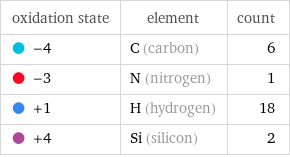
oxidation state | element | count -4 | C (carbon) | 6 -3 | N (nitrogen) | 1 +1 | H (hydrogen) | 18 +4 | Si (silicon) | 2
Orbital hybridization
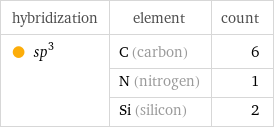
hybridization | element | count sp^3 | C (carbon) | 6 | N (nitrogen) | 1 | Si (silicon) | 2
Topological indices
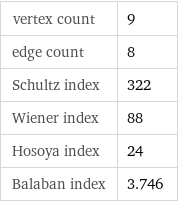
vertex count | 9 edge count | 8 Schultz index | 322 Wiener index | 88 Hosoya index | 24 Balaban index | 3.746